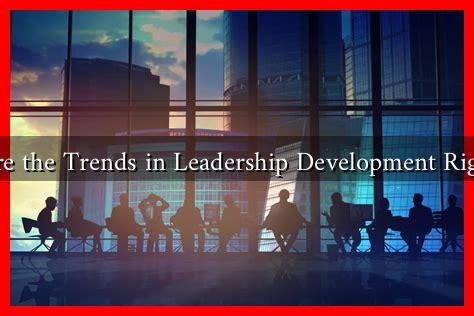-
Table of Contents
What Are the Trends in Leadership Development Right Now
In an ever-evolving business landscape, leadership development has become a critical focus for organizations aiming to foster innovation, adaptability, and resilience. As we navigate through 2023, several key trends are shaping the way leaders are developed. This article explores these trends, providing insights into how organizations can effectively cultivate their leadership talent.
The Shift Towards Emotional Intelligence
Emotional intelligence (EI) has emerged as a cornerstone of effective leadership. Leaders with high EI can better understand and manage their own emotions, as well as empathize with others. This skill is increasingly recognized as essential for fostering a positive workplace culture and driving team performance.
- Case Study: Google – Google’s Project Aristotle highlighted that psychological safety, a component of EI, is crucial for team success. Teams that feel safe to express their thoughts and emotions are more innovative and productive.
- Statistics – According to a study by TalentSmart, 90% of top performers have high emotional intelligence, underscoring its importance in leadership roles.
Emphasis on Diversity and Inclusion
Organizations are increasingly recognizing the value of diverse leadership teams. Diverse perspectives lead to better decision-making and innovation. Leadership development programs are now focusing on creating inclusive environments where all voices are heard.
- Example: Unilever – Unilever has committed to ensuring that 50% of its leadership roles are held by women, demonstrating a proactive approach to diversity.
- Research Findings – McKinsey’s report on diversity shows that companies in the top quartile for gender diversity are 21% more likely to outperform their peers in profitability.
Integration of Technology in Leadership Training
The rise of digital tools has transformed leadership development. Virtual reality (VR), artificial intelligence (AI), and online learning platforms are being utilized to create immersive and personalized training experiences.
- VR Training – Companies like PwC have implemented VR training programs that simulate real-life leadership challenges, allowing leaders to practice their skills in a safe environment.
- AI-Powered Learning – AI tools can analyze individual learning styles and provide tailored content, making leadership training more effective and engaging.
Focus on Continuous Learning and Agility
In today’s fast-paced world, the ability to adapt and learn continuously is vital for leaders. Organizations are shifting from traditional, one-time training sessions to ongoing development programs that encourage lifelong learning.
- Example: LinkedIn – LinkedIn Learning offers a plethora of courses that allow leaders to upskill at their own pace, fostering a culture of continuous improvement.
- Statistics – A report by the World Economic Forum indicates that 94% of employees would stay at a company longer if it invested in their career development.
Mentorship and Coaching as Key Components
Mentorship and coaching are becoming integral to leadership development. Organizations are recognizing that personalized guidance can significantly enhance a leader’s growth trajectory.
- Peer Mentoring – Programs that facilitate peer mentoring can create a supportive network for leaders, allowing them to share experiences and learn from one another.
- Executive Coaching – Many organizations are investing in executive coaching to help leaders navigate complex challenges and enhance their decision-making skills.
Conclusion
The landscape of leadership development is rapidly changing, driven by the need for emotional intelligence, diversity, technological integration, continuous learning, and personalized mentorship. Organizations that embrace these trends will not only cultivate effective leaders but also foster a culture of innovation and resilience. As we move forward, it is essential for companies to adapt their leadership development strategies to meet the demands of a dynamic business environment. By doing so, they can ensure that their leaders are equipped to navigate the challenges of tomorrow.
For further insights on leadership development trends, consider exploring resources from the Forbes Human Resources Council.


